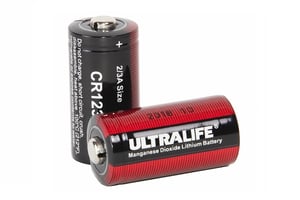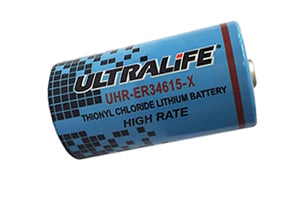Approximately 60% of convicted burglars stated the presence of a security system influenced their decision to target another home, according to a report by the University of North Carolina. Therefore, owners of residential or commercial property portfolios should invest in protecting them against theft. Here we look at the traditional and modern home security systems that are available to landlords and property managers – and examine their portable power requirements.
Old school security
One of the earliest examples of home security is the peephole (“door viewer”) that was invented by George Winningham in 1932. Still used to this day, residents within a property can see who is on the other side of the door whilst remaining invisible. However, peepholes rely on the resident being at home and physically able to get to the door, so advancements in home security have focused on protecting the property where this is not possible, by detecting suspicious activity and raising the alarm.
 An early example of this is the first motion sensor used for an alarm system, invented by Samuel Bagno in the early part of the 1950s. Commonly used in wireless motion detectors, the sensors can be attached to the outside wall to trigger an alarm or turn a light on to alert residents or neighbours of activity. Now a traditional and affordable method of home security, detectors are usually powered by non-rechargeable batteries, which generally offer a wider operating temperature range than rechargeable counterparts, making them better suited for use outdoors. As many detectors are installed away from a mains power supply, they often rely solely on battery power to function. This makes the performance of the battery essential as, should the battery go flat, an intruder may notice that the light or alarm has not been activated, making the property a target.
An early example of this is the first motion sensor used for an alarm system, invented by Samuel Bagno in the early part of the 1950s. Commonly used in wireless motion detectors, the sensors can be attached to the outside wall to trigger an alarm or turn a light on to alert residents or neighbours of activity. Now a traditional and affordable method of home security, detectors are usually powered by non-rechargeable batteries, which generally offer a wider operating temperature range than rechargeable counterparts, making them better suited for use outdoors. As many detectors are installed away from a mains power supply, they often rely solely on battery power to function. This makes the performance of the battery essential as, should the battery go flat, an intruder may notice that the light or alarm has not been activated, making the property a target.
Whilst alkaline 9V batteries are commonly used in wireless motion detectors, due to wide retail store availability, the service life is far less than can be offered by Lithium. Depending on use and device cut-off voltage, the Ultralife Lithium 9V battery can offer up to five times the capacity of a leading alkaline 9V. Therefore, property managers with a large portfolio to manage or maintain should not need to replace the batteries as frequently – saving time and money. Whilst investing in Lithium 9V for motion detectors, they can also be used in a wide range of other applications throughout the property, including smoke and carbon dioxide detectors.
Present day alternatives
Although reliably powered traditional security devices are useful for informing nearby residents of suspicious activity, in the digital age, property owners have a wealth of smart home technology at their fingertips that can send security alerts directly to smartphones. This is important because, contrary to popular belief, the majority of home burglaries take place during the day when most people are at work or school, so neighbors may not be around to prevent the intruder.
 One of the most popular forms of smart home technology are smart cameras that sense any activity at the property and record video footage for the property owner to view on their phone either in real-time or after the event. To conserve battery power, smart cameras generally only record when motion is detected by a PIR (passive infrared) sensor. However, many batteries that come supplied with smart cameras still have a limited shelf life of between four to six months, increasing the maintenance requirements for the property owner. In comparison, Ultralife’s new China manufactured CR123A battery has a shelf life of around 10 years and a capacity of 1500mAh.
One of the most popular forms of smart home technology are smart cameras that sense any activity at the property and record video footage for the property owner to view on their phone either in real-time or after the event. To conserve battery power, smart cameras generally only record when motion is detected by a PIR (passive infrared) sensor. However, many batteries that come supplied with smart cameras still have a limited shelf life of between four to six months, increasing the maintenance requirements for the property owner. In comparison, Ultralife’s new China manufactured CR123A battery has a shelf life of around 10 years and a capacity of 1500mAh.
Listening for a break-in
One of the downsides of motion detectors and smart cameras is that field of vision can be limited. According to Protect America, Inc., ‘95% of all home invasions require some sort of forceful entry, be that breaking a window, picking a lock, or kicking in a door’. If your property has a large number of windows, making it a vulnerable target, the use of a Glass Break Detector can be invaluable. These detectors listen for the sound of glass breaking (this can include tampered, wired, laminate, ordinary plate and more types) before triggering the alarm. In the past, the uptake of Glass Break Detectors was slowed by their tendency to trigger false alarms, but the technology has improved to minimize this. Now that the detectors are triggered less frequently, it is important to ensure that the batteries are designed for long periods of dormancy. Ultralife’s CR123A range are equipped to deal with infrequent and intense bursts of energy, without deteriorating quickly.
Detecting a suspicious entry
 Almost 30% of burglars enter a home through an unlocked door or window, therefore, as well as technology that listens for glass breaking, it is important to protect windows and doors using sensors that detect when they are opened. Most of the devices on the market work by separating the sensor’s body from a magnet whenever the door or window is opened, triggering a warning signal. As these alarms are triggered on every open, batteries such as Ultralife's UHR-ER34615-X are ideal because they have a high and stable operating voltage and offer superior current capability. The UHR-ER34615-X also boasts a low self-discharge rate (less than 2% after 1 year of storage at 23°C).
Almost 30% of burglars enter a home through an unlocked door or window, therefore, as well as technology that listens for glass breaking, it is important to protect windows and doors using sensors that detect when they are opened. Most of the devices on the market work by separating the sensor’s body from a magnet whenever the door or window is opened, triggering a warning signal. As these alarms are triggered on every open, batteries such as Ultralife's UHR-ER34615-X are ideal because they have a high and stable operating voltage and offer superior current capability. The UHR-ER34615-X also boasts a low self-discharge rate (less than 2% after 1 year of storage at 23°C).
Finally, we come full circle, as there is now a successor to the peephole – the smart doorbell. Combining features of a traditional peephole and doorbell, when the smart doorbell is rung, or a motion sensor detects an approach to the door, it shows a live video feed to the property owner, allowing them to see who’s on the other side. However, as with most of the modern home security devices, the video feed may also be accessed from a smartphone app even when the resident is not at home.
Conclusion
With most smart home products, the batteries used vary between manufacturer. However, the considerations remain very similar. Choosing a power source that is reliable will reduce the likelihood of the device losing power as frequently. Furthermore, non-rechargeable batteries tend to offer a wider operating temperature, making them more suitable for use outdoors. If you own a large number of commercial or residential properties, speaking to a battery manufacturer can ensure that you get the best power products for home security devices, helping you to secure your assets and saving you money in the long-term.


